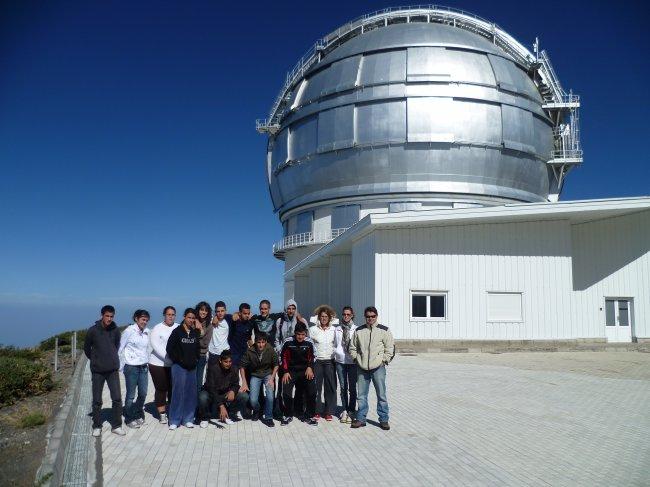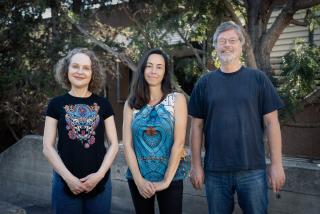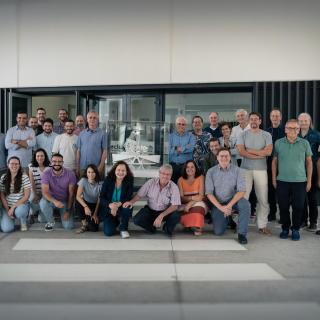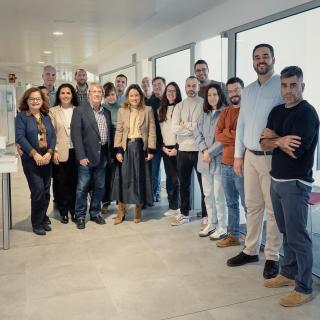The eduational programme “Our students and the Roque de los Muchachos” began its eighth edition yesterday with the Secondary School Villa de Mazo, and the Primary plus Secondary School Santo Domingo de Guzmán opening the school year 2016/2017. It is a project for training and outreach whose aim is to familiarize the pupils and the teachers at secondary schools with the astrophysical research carried out at the Observatorio del Roque de los Muchachos in Garafía (La Palma). Since 2009 4,800 boys and girls have benefitted from this programme whose aim is to bring astrophysical research closer to all the centres on the island which teach the 4th year of Secondary Education.
This year we will continue the activities carried out last year. “They comprise a set of lectures on current topics in astronomy given in the schools, plus a visit to the Roque de los Muchachos Observatory”, explains David García, an astronomer with the Gran Telescopio CANARIAS and co-ordinator of the programme “where the students participate in practical workshops which deal with a variety of aspects of the behaviour of light and with astronomical observation: a demonstration with an infrared camera, spectroscopy, light pollution, and solar observations.” At the observatory they will also visit the Gran Telescopio CANARIAS (GTC), which is the largest optical-infrared telescope in the world, the Nordic Optical Telescope (NOT) the Italian National Galileo Telescope (TNG), the William Herschel Telescope (WHT) of the Isaac Newton Group (ING) or the MERCATOR telescope.
Other outreach projects
The programme “Our students and the Roque de los Muchachos” is not limited to Secondary School students, but also offers a range of activities at other levels. An example is the didactic game “Selene” which was introduced in a number of Primary Schools on the Island in previous years, in which boys and girls learned bout the origin and formation of the moon while playing the game. Other specific activities have been programmed for the pre-university course, and also for students in Professional Training, which include visits oriented towards their training requirements, at the La Palma Astrophysics Centre (CALP) and also at the ORM.
Examples of these projects have included “SolarLab”, organized by the Instituto de Astrofísica de Canarias (IAC) which over the years gave information and instruction about the Sun, our star, to over 80,000 students (6,200 of them on La Palma), in all the Centres of Secondary Education in the Canary Islands, with one week’s possibility to use a solar telescope with which they could make observations and do practical work.
In addition, in order to give wider publicity the educational activities within this project, the programme “Our students and the Roque de los Muchachos” has been presented at a number of national and international conferences, such as the European Week of Space Science (EWASS) which was held last year in Tenerife, and the Annual Meeting of the Spanish Astronomical Society, (SEA) held last June in Bilbao.
The “Antares” project, an initiative of the Cabildo of La Palma, collaborated in this programme by purchasing one of the telescopes used, and which was also utilized to give a training course on telescopes to 32 teachers at the La Palma Astrophysics Centre (CALP). Similarly, the Island Transport Company (TILP), and the Cabildo of La Palma covered the cost of transporting the students to the Roque de los Muchachos Observatory.
“This outreach programme, which is now well established, is an example of the necessary relationship between the Observatory and the school community on the island. The involvement of teachers, students, and the staff of the Observatory, and also the participation of companies and La Palma’s public institutions shows the high degree of collaboration reached by this interesting educational project during the years when it has been operating”, states Juan Carlos Pérez Arencibia, the Manager of the ORM. This opinion was shared by Emilio Molinari and Thomas Augusteijn, atronomers, and the directors of the TNG and the NOT, respectively. “We are involving La Palma students in our research work at the ORM, while at the same time we are investing in their future and in the future of the ORM itself, because someone will need to continue studying the universe”, adds Emilio Molinari. “Just as science is an integral part of society, the ORM is an integral part of La Palma. We depend on researchers who come from many countries, and also from the Island, so it is our duty to show what we are doing, above all to young people, because they are the researchers of the future”, explains Thoma Augusteijn. Marc Balcells, the director of the ING places special importance on the fascination aroused by the astronomical telescopes on people, both young and old. “Many youngsters are pulled toward their science by astronomical experience at an early age, and then go on to scientific careers”. Saskia Prins, a support astronomer at the MERCATOR telescope added the comment that she hoped "that this programme will contribute to an increasing number of girls from La Palma becoming interested in astronomy".
Our students and the Roque de los Muchachos” is an activity organized by the Grupo LPIYA, formed to work in the International Year of Astronomy, 2009, which aims at uniting the efforts of the scientific institutions working in the ORM in matters of astronomical outreach on the Island of Palma.
More information:
- Web del programa “Nuestros alumnos y el Roque de los Muchachos”
- David García, coordinador del programa: david.garcia [at] gtc.iac.es (david[dot]garcia[at]gtc[dot]iac[dot]es) y 922 42 57 20
- Juan Carlos Pérez Arencibia, administrador del ORM: jcperez [at] iac.es (jcperez[at]iac[dot]es) y 922 42 57 10



